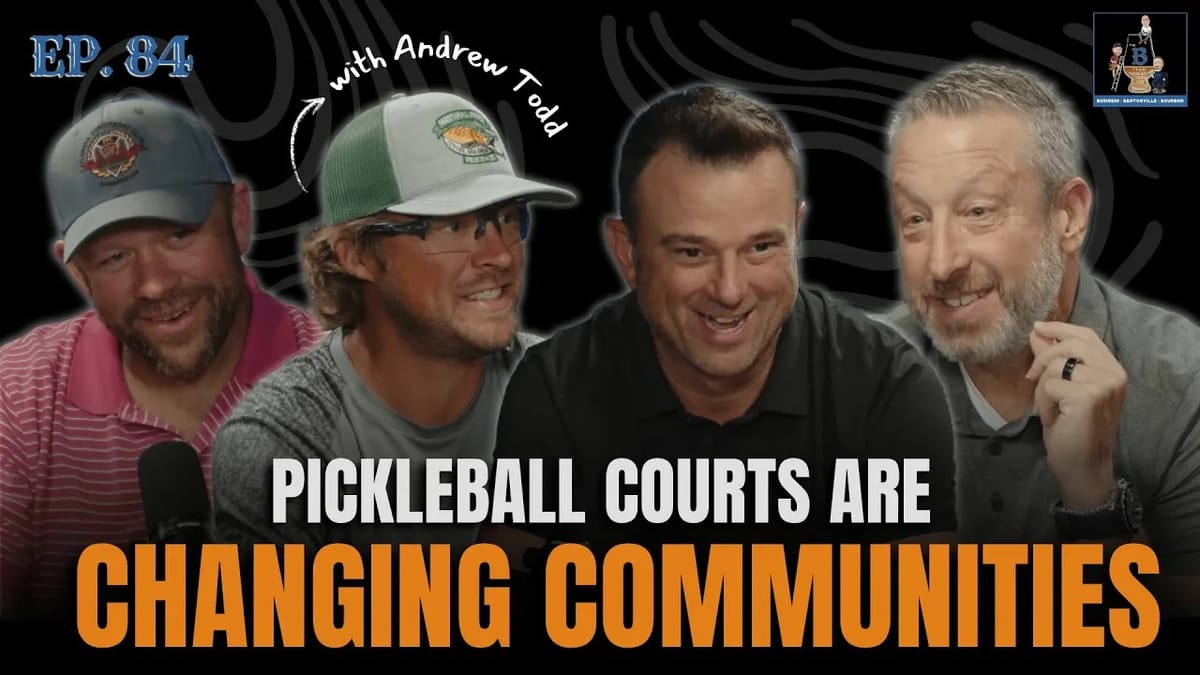The bottle was hot and the takes were hotter, but beneath the jokes is a story about how courts are bringing people together across Arkansas. We sit down with Andrew Todd, teaching pro turned owner of Generation Sports Construction, to unpack the real work behind the pickleball boom and the quiet renaissance of public parks, private clubs, and even backyards.
Andrew walks us through the full build: excavation, grading, concrete, coatings, fencing, lighting, and the practical choices that shift a project from “nice idea” to “game on.” He breaks down true costs for a backyard pickleball court, realistic 40-day timelines, and why retaining walls can swing a budget before a line gets painted. For parks and cities, we dive into conversions, four pickleball courts will fit on one tennis court, and how that multiplier changes access, programming, and community engagement.
If you’ve ever wondered why some courts feel fast and others grip like sandpaper, you’ll love the surface science. Andrew explains how sand-to-paint ratios tune pace, why asphalt ages differently from concrete, and how simple upkeep can add seasons to a surface. We also compare options: modular tiles for family flexibility, classic acrylics for consistent bounce, and the high-maintenance romance of clay that shines in the right climates but demands daily care.
From dawn starts in 100-plus-degree heat to night sessions to protect fresh coats, Andrew’s hands-on leadership shows how logistics and craftsmanship meet in the field. And yes, we talk about pickleball culture: humbling first tournaments, smart positioning, and the social magnet that keeps parks full after 5 p.m. Whether you’re a city planner eyeing conversions, a club manager targeting tournaments, or a homeowner dreaming of a backyard court, you’ll walk away with clear numbers, better questions, and a roadmap for turning space into a place people love.
Curious what it would take to build or resurface your court? Subscribe, share this with a friend who plays, and leave a review with your biggest question. We might answer it on the next show.
More About this Episode
From Tennis Pro to Court Builder: How Andrew Todd is Resurfacing the Sports Landscape in Arkansas
The explosion of pickleball across America isn’t just a fleeting trend, it’s reshaping how communities approach recreation, fitness, and use of public spaces. And in Arkansas, one entrepreneur is playing a critical role in that transformation. Andrew Todd, former tennis pro and now the owner of Generation Sports Construction, is taking his lifetime of experience on the court and putting it directly into building and resurfacing courts all over the state.
This isn’t just a story about entrepreneurship. It’s a story about understanding your craft so deeply that you can rebuild it from the ground up, literally.
From the Tennis Court to Construction
Andrew’s journey into court construction isn’t one you hear every day. With a background as a tennis teaching professional and a strong track record in the consumer packaged goods (CPG) business world, Todd eventually found his way back to his roots: the game of tennis. Only now, instead of coaching backhands and footwork, he’s laying the very surfaces athletes train and compete on.
“I’m not the founder, but I’m now the sole owner of Generation Sports Construction,” Todd explained. “We build and resurface tennis and pickleball courts across the state. We’ve done work at some of the largest facilities in Arkansas.”
What makes Todd’s story so compelling is that he doesn’t just oversee the work, he’s in the trenches with his team, running equipment, laying paint, and making sure every surface meets his high standards. When someone says “owner-operated,” this is what they mean.
Building More Than Courts, Building Access and Community
One of the defining features of Andrew Todd’s business is its mission to improve access to quality courts in communities both large and small.
“We’re doing everything from resurfacing major parks like Burns Park in Little Rock to transforming old, cracked basketball courts into new pickleball venues in small towns like Waldron and Dardanelle,” Todd said.
That grassroots reach matters. In cities and towns across Arkansas, communities are sitting on decades-old recreational spaces that have fallen into disrepair. Through Generation Sports Construction, those forgotten courts are being reimagined and revived.
Take Dardanelle, for example. A town with three aging tennis courts now plans to turn them into nine modern pickleball courts, helping meet skyrocketing demand for the sport.
These projects aren’t driven by glitzy marketing campaigns. “It’s mostly word of mouth,” Todd noted. “I know a lot of the tennis pros in the state, and once people see the quality of work we’re doing at places like Burns Park or Memorial Park, they reach out.”
Pickleball’s Meteoric Rise, and What It Means for Builders
Todd's business is a perfect example of how market trends shape entrepreneurship. Pickleball, which blends elements of tennis, badminton, and ping pong, has exploded in popularity, particularly in communities with aging populations and among younger families looking for low-impact, high-fun activities.
“We’re seeing a lot of cities converting tennis courts to pickleball,” Todd said. “One tennis court can fit four pickleball courts, so it allows more people to play at once and brings more people into the parks.”
Pickleball’s appeal to all ages has created both challenges and opportunities for cities. Aging infrastructure can’t support the demand, and new builds require significant investment, $45,000 to $50,000 for a quality pickleball court, depending on the condition of the land.
But for cities, HOAs, developers, and even homeowners with extra yard space, that investment is proving worthwhile. “A lot of the work we’re doing now is for apartment complexes, land developers, and private homes,” Todd said. “People want these amenities where they live.”
Customization and Quality: Not All Courts Are Equal
Beyond volume, what makes Generation Sports Construction stand out is its focus on quality and customization. Todd’s firsthand experience as a player gives him a unique advantage. He knows how a court should feel under your feet, how it should respond to spin, and how temperature and surface wear can affect gameplay.
This insight allows him to tailor courts based on the needs of the client. “You can adjust the pace of the court depending on how much sand you mix in with the paint,” Todd explained. “More sand makes it grippier and slower. Less makes it faster.”
For casual players, this may not seem like a big deal. But for serious players, and organizations hosting tournaments, these nuances matter. And Todd’s team works with clients to deliver the court that matches their play style and needs.
Indoor vs. Outdoor, Public vs. Private, The Work Keeps Expanding
Another interesting trend Todd is seeing is the growth in private court construction. While city projects and resurfacing jobs make up the bulk of his work, about 70% by his estimate, the demand for backyard courts is growing.
“If someone has a flat piece of land and the budget, we can do it all,” Todd said. “Excavating, grading, fencing, lighting, surfacing, everything. We’re seeing more and more people who want to avoid the crowded public courts and bring the game to their backyard.”
The timeline? Surprisingly fast, 40 to 45 days from start to finish, weather permitting. Concrete takes about 30 days to cure, but the surfacing itself takes just a few days afterward.
“We also work with excavation and concrete partners who turn the base around quickly, so we’re not dragging out projects,” Todd added.
A One-Stop Shop for Court Construction
Todd’s approach is comprehensive. Whether it's starting from scratch or reviving neglected surfaces, Generation Sports Construction manages every element of the build. From fencing and retaining walls to paint and final surfacing, the team delivers turnkey projects with minimal hassle for the client.
And while the majority of their work is on tennis and pickleball courts, Todd noted that they’re open to resurfacing basketball courts and even exploring growth into Padel courts, another hybrid racquet sport gaining traction.
Why This Matters for Arkansas, and Beyond
Sports infrastructure often gets overlooked in broader discussions about community development, but the growth of court sports in Arkansas highlights how these investments shape local life. They bring people outside, promote fitness, and offer gathering spaces for neighbors and friends.
And businesses like Generation Sports Construction are quietly enabling that progress.
Todd’s business reflects not only a smart response to market demand but a personal commitment to quality and community. He’s not just cashing in on a trend, he’s building something meaningful, both figuratively and literally.
“It’s an investment,” Todd admitted, “but it pays off in usage, health, and community. If you’re going to do it, you want to do it right.”
And that’s exactly what Todd is offering, doing it right.


Member discussion: